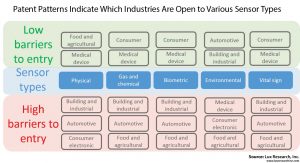
Sensors patents show lowest barrier to entry
Stephen Law
Automation / Robotics Electronics Engineering IoT Supply Chain Wearable Technology sensors$4.3-billion in investment has driven nearly 30,000 patents, most crowded in automotive and building & industrial sensors, says Lux Research
Over the past decade, investors have pumped $4.3-billion into the development of sensors, but it’s the pattern of the 28,927 sensor patents granted since 1975 that reveal the true value and future potential of these patents, according to Lux Research.
To identify growing markets and those that are already crowded, Lux Research analyzed patent trends for five sensor types: physical, gas and chemical, biometric, environmental and vital signs – across five value chains including automotive, food and agriculture, consumer, medical, and building & industrial.
Sensor patents targeting consumer electronics & medical devices lower entry barriers
The study found that sensor patents targeted at consumer electronics and medical device industries have the lowest barriers to entry, while those patented for use in automotive, and building and industrial segments, have the highest barriers.
“While the physical sensor patent space is the most crowded, there are opportunities for component and module manufacturers even in industries that have high barriers to entry,” says Tiffany Huang, Lux Research Associate and lead author of the report titled, “Sensor Patent Landscape: Sorting through the Crowd in Search of Gold.”
“An approach focusing on unmet technical needs in each market will lead to success,” she added.
Lux Research analysts studied patent trends of five different sensor types across five different value chains. Among their findings:
* Most patents are for physical sensors. Since 1975, a total of 28,927 sensor patents have been granted. Of them, 21,078, or 73%, are for physical sensors. Gas and chemical sensors are a distant second with 2,446. Nearly 60% of the patents do not target a particular industry. Of the ones focused on a specific industry, the most popular is the building and industrial space, with a 58% share.
* Corporations corner most patents. Among these sensor patents, 71% have gone to corporations, with the rest going to universities and independent research organizations. Among the corporations, Honeywell holds the most — 1,354, a majority of which are for physical sensor types. Next are General Electric with 989 and Northrop Grumman with 752.
* Patent quality, not numbers, is key. Patenting is not a numbers game — quality matters. Even though Honeywell has five times more patents than Bosch, Bosch holds leadership positions in three segments: building & industrial, consumer and automotive.

